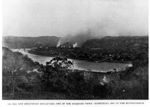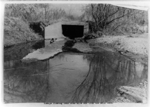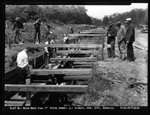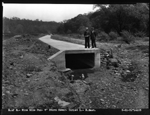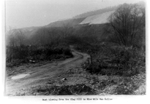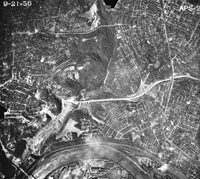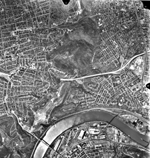We live at a time when human history and natural history appear to be on a collision course. The increasing tempo of human activity has been matched by rapid consumption of finite natural resources, resulting in what ecologist George Woodwell terms "biotic impoverishment." Few places have had more of such impoverishment, or have had a harder struggle the consequences, than the City of Pittsburgh. The dichotomy between preservation of open space and disposal of waste in Pittsburgh has larger implications; as does the current effort to reclaim open space out of waste. At the most fundamental level, the question is one of coexistence: can we live in some degree of harmony with our surroundings? In the long run, we may have little choice.
The conflict between profit
and preservation, commodification and conservation has always been present
in American life; it has been grist for the mills of environmentalists
and historians alike. For the most part, their focus is on wilderness,
deforestation, water rights, and western expansion. Yet, when MacArthur
Fellow and western U.S. historian Patricia Nelson Limerick writes of the
need for a "third draft" of U.S. history -- one that views economic development
in a new and more critical light -- she omits urban American history.
For Limerick, the first draft was one of manifest destiny and expansion;
the second of impartial bureaucrats protecting the public good through
public works and efficient management of public lands. For Limerick, both
imposed significant, perhaps unacceptable costs on the land and on the
public, costs which a third draft of history might investigate more thoroughly.
Her third draft has yet to be written, and she concedes that it may never
be. Nonetheless, Limerick's typology should be expanded beyond the U.S.
west. As the Nine Mile Run slag pile demonstrates, human economic activities
have often left a dismal environmental record. Supposedly impartial public
administrators could do nothing to prevent destruction of the landscape.
As the Nine Mile Run site now enters a new phase of development, the old
tensions between community, government, development and elites have been
reasserted, but with some promise that things can be different this time.
The history of urban communities such as Pittsburgh has enjoyed drafts
similar to Limerick's analysis of the west and the third draft may, at
Nine Mile Run, finally be underway.
Pittsburgh in 1900 was a remarkable development. Smoke from coal-burning factories, ships, steam locomotives and homes enveloped the community. Visitors noted barren hillsides and speculated that nothing could grow under such conditions. Margaret Byington, viewing the city from Homestead early in the 20th century, wrote "The trees are dwarfed and the foliage withered by the fumes; the air is gray, and only from the top of the hills above the smoke is the sky blue." In 1907, 622 people died from typhoid fever, the result of contaminated drinking water, more than any other city. The temperature of the Monongahela River was known to top 120 degrees Fahrenheit. Narrow streets were choked with traffic. The riverfronts were given over to steel mills, rail lines, parking lots and barge traffic. A handful of parks were clustered in the city's wealthy east end communities. Playgrounds and public recreation were otherwise unavailable. Sanitary conditions in working class neighborhoods were deplorable. Hundreds of workers were injured or killed in the city's factories. Sewage treatment was not available and water lines reached working communities only intermittently. Workers' housing was a shambles. In short, life in industrial Pittsburgh could be described as a Hobbesian existence -- short, nasty and brutish.
As the costs of industrialization became increasingly apparent, questions of Pittsburgh's development pattern grew more urgent. Pittsburgh grew exponentially during the industrial revolution. From a City of 50,000 in 1860, it topped 300,000 in 1900 and became one of the largest cities in America. Pittsburgh was home to the nation's first oil refinery and its first steel mill. The city expanded its area from a little over one square mile to thirty. After 1907, when the North Side was annexed, Pittsburgh approached a half-million residents. For over 100 years, the City grew without any significant regulation or management. The result was an admixture of industrial, commercial and residential crammed into each region of the city and surrounding communities. Streets and essential services were likewise mismatched to the needs of the landscape and there was no notion of land use controls.
The rise of Pittsburgh's professional and business elite late in the 19th century brought with it a nascent urban environmentalism seeking both voluntary controls on and rational planning for the Pittsburgh landscape. The limits of the first draft of Pittsburgh's history were thus reached; unlimited economic development was testing human tolerance beyond endurance. The attempt of urban elites to impose their own will onto the landscape, however, relied upon moral suasion and rational behavior; the political and economic system of industrial America was not particularly responsive to either.
Turn-of-the-century Pittsburgh spawned a Civic Club, an Engineers Society, a Chamber of Commerce, and other civic organizations devoted to urban improvement. These organizations sought an efficient city freed of the burdens of smoke, sewage, traffic, and dilapidation. In the case of the Civic Club, the effort went beyond aesthetics and was a moral issue: a dirty environment led to crime and immorality. The effort was in part informed by Frederick Law Olmsted's belief that a healthy atmosphere and environment would directly improve the well being of urban residents. By providing a healthy and attractive city, with recreation and open space, many of the city's professionals believed that working class pathologies could be ameliorated. In short, the process could serve the professional and business classes' paternalism and self-interest. Opportunities for public-sector partnerships, however, were limited. The Flinn-Magee Republican machine had ruled the city since 1879 and did not embrace reform. After 1906, however, Democratic Mayor George Guthrie opened new opportunities for civic involvement.
Nine Mile Run was an important element in a larger strategy to bring parks and recreation to the City. Early 20th Century advocates for open space and land use controls in Pittsburgh targeted Nine Mile Run for preservation. They had three options at their disposal. The first and most direct was to acquire the land for a park and add it to the City's growing park infrastructure. The second was to create a city plan, implement strict zoning, and prevent intrusions into sites such as Nine Mile Run. The third was to let the market take its course. The latter, which was essentially a default, took place.
Protected open space in Pittsburgh was limited to four parks and a smattering of playgrounds. The largest of these, Schenley Park, had been donated to the City rather than acquired. Few of these resources were available to working class families. Nine Mile Run could have been an exception. At the turn of the century, Nine Mile Run was among Pittsburgh's more remarkable landscapes and one of the largest undisturbed areas in the City. It represented Pittsburgh's last remaining access point to the Monongahela River; industry had already seized the rest of the waterfront. The watershed drains the East End of the City, while the creek itself traverses a steep slope on its southerly course to the River. A variety of communities including Wilkinsburg, Homewood, Edgewood, and Squirrel Hill surround it. For much of the 19th century it was of little note, a community of small landowners several miles from the core of Pittsburgh. Photographs from the 1920s show a lush valley with little development. Uses in the late 19th century included a salt mine, a few farms and houses, and a small golf course.
The reform forces gathered strength in the early 20th century. Although lumped together as "progressives" different issues drew in different constituencies. Each attempted to create professional bureaucracies to impartially administer controls on waste and pollution. Each attempt failed. Smoke control ordinances were passed in the late 19th century in response to complaints from the Civic Club and other reformers. In 1907 a citywide inspector of smoke was appointed to enforce the ordinances. But the policy proved ineffective because there was no substitute for coal in transportation, industry, and home heating. Technology for cleaner combustion was limited, and cleaner fuels were not available. Smoke continued to choke Pittsburgh into the 1960s.
The struggle for open space in Pittsburgh was a part of the much larger effort to exert control over the degradation of the air, land and water of the region. Once more the region's turn-of-the-century elites attempted to use the same public policy tools that failed in the case of sewage and smoke control. The effort represented Limerick's second draft of history, in which experts and professionals limit the impact of capitalism and provide the benefits of efficiency and economic opportunity. In the case of smoke control, sewerage, and open space that effort directly conflicted with the ongoing development of the first draft of urban history -- that of unregulated development -- and did not include any larger effort to question the costs and benefits of regional development. Both drafts sought continued use of the landscape for industrial purposes; neither sought coexistence nor did they seek to directly confront the mounting human and environmental costs of the industrialized city.
In 1909, George Guthrie, a reform Mayor and one of the few Democrats elected in the early twentieth century, appointed a Civic Commission to deal with the deteriorating urban landscape. Its mandate was broad but its powers non-existent. Nevertheless, it represented Pittsburgh's first major attempt at environmental improvement through a public-private partnership. The Pittsburgh Civic Commission was made up the city's top business and professional leaders. Notably lacking was the metals industry. The group interpreted its mandate as one of urban planning and reform, encompassing rail, water, and street systems, public lands and buildings, sewage, control over development, smoke abatement, building codes and further studies. In sum, the initial desire of the Commission was nothing less than a comprehensive city plan with a broad regulatory mandate overseen by impartial representatives such as those on the Commission itself. Frederick Law Olmsted, Jr., whose Pittsburgh efforts had included landscaping the H. J. Heinz home in Pittsburgh, was engaged to assist the Commission's members (including Heinz) in their deliberations. Unfortunately for the Commission, Mayor Guthrie left office in 1909 and was replaced by Republican William Magee, nephew of long-time Mayor Christopher Magee. Magee had little use for the Commission.
The Commission's work grew out of, but failed to embrace the findings of, the Pittsburgh Survey of 1907. The survey, an independent review of the city's urban conditions, had documented Pittsburgh's deplorable environmental and social conditions. The Commission, however, quickly set aside the social agenda of the Survey, and instead focused on environmental issues. The Survey had recommended better working conditions, more sanitary housing, and economic improvement for the region's workers. Representing newer, more professionalized businesses, the Commission's members had no tolerance for the favoritism and patronage of the old Flinn-Magee machine. They also had little tolerance for major social changes; they looked to changes in urban systems to gradually bring about social reform. Half the Commission's members appeared in the Blue Book, the city's social register. A quarter of the members were lawyers and over a third were businessmen. Four workers were added by Guthrie, but they were greatly outnumbered. Wealthy resident of the East End, the Commission's members strongly embraced the paternalism of the larger reform movement.
The Commission's primary project was its plan for the City, prepared by Frederick Law Olmsted, Jr., son of the great designer and architect. Olmsted's report, completed in 1910 and published in 1911, was among the Commission's better efforts. He recommended a new system of downtown roads and conservation of Pittsburgh's steep slopes. He took a stab at a comprehensive plan for the City including improvements in the riverfront, rail links, and more. He was also the first to recognize the value of Nine Mile Run:
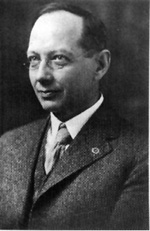
Frederick Law Olmsted, Jr. |
Perhaps the most striking opportunity noted for a large park is the valley of Nine Mile Run. Its long meadows of varying width would make ideal playfields; the stream, when it is freed from sewage, will be an attractive and interesting element in the landscape; the wooded slopes on either side give ample opportunity for enjoyment of the forest, for shaded walks and cool resting places; and above all it is not far from a large working population in Hazelwood, Homestead, Rankin, Swissvale, Edgewood, Wilkinsburg, Brushton, and Homewood; and yet it is so excluded by its high wooded banks that the close proximity of urban development can hardly be imagined. If taken for park purposes, the entire valley from the top of one bank to the top of the other should be included, for upon the preservation of these wooded banks depends much of the real value of the park. |
Magee's Administration, however, proceeded without Olmsted. Magee embraced planning insofar as it dealt with improving transportation and commerce; the explosion of automobile traffic in the downtown business district made improvement imperative. The rest of Olmsted's recommendations -- conserving steep slopes and purchasing Nine Mile Run in particular -- were ignored. The failure was significant. Olmsted's vision would have provided a variety of open space and aesthetic improvements to the region. Instead, Magee promoted a $10 million bond issue for infrastructure that avoided open space, smoke control, and sewer systems. The Civic Commission refused to endorse Magee's proposal and urged that the bond be defeated. It won handily and the Civic Commission faded away. Purchasing the Nine Mile Run valley also faded, but one questions whether Nine Mile Run could have been acquired in this period. Olmsted, for instance, did not aggressively pursue the matter. Having filed his report, Olmsted left Pittsburgh but stayed in touch with all sides of the debate, urging them on. He corresponded with Magee, urging greater attention to an overall city plan, but took no active role in the development of the region. Having proposed a park, he left it to his clients on the Commission to pursue the matter. The Civic Commission clearly would have preferred that Magee's bond issue provide conservation funding, including the preservation of Nine Mile Run; but the fight over Magee's bonds also seemed to devolve into a grudge match between the Commission and Magee. Retaining open space was lost in this fight.
The effort to acquire Nine Mile Run was also subordinated to the city's need for new playgrounds. The Civic Club of Allegheny County, which was also dominated by Blue Book members, sought active recreation rather than open space, and managed to outcompete the Civic Commission's recommendations for scarce city funds. The City issued bonds throughout the 1910s for playgrounds and to maintain the four existing parks; but no effort was made to acquire Nine Mile Run.
Magee's long tenure did include support for planning. In 1911 the state legislature created with Magee's support the Pittsburgh Department of City Planning. The Department promptly came up with an action plan for itself including a review of the road system, an investigation of river improvements, improvements to public buildings and lands including parks, adequate water supply, smoke abatement, and intergovernmental relations. In sum, it was almost everything the Civic Commission had asked for. Once again, however, advocates for rational use of the landscape were to be disappointed. The legislature and the City Council gave the Department little actual power. Planning was advisory and the Department staff and the Planning Commission that oversaw it had no regulatory authority. Nonetheless, in 1912 the Planning Department began work on a comprehensive city plan. In 1913, the Department boasted eight staff people. But during World War I its small staff was all but eliminated in a cost cutting move. No comprehensive plan ever emerged, and no new parks were created. Similarly, Magee established a Bureau of Recreation to promote playgrounds, but its professional manager resigned after only two years and little was accomplished. The professional bureaucracy that community elite had hoped would bring effective government to Pittsburgh collapsed in a few years. Whether it would have been up to challenge of managing Pittsburgh's diverse needs was never tested; it never got a chance. Nevertheless, effective planning may have been the most effective remaining means of protecting open space such as Nine Mile Run.
As it became increasingly apparent that the Magee Administration was not willing to expend funds on land acquisition; land use restrictions were becoming Nine Mile Run's only hope. Indeed, park acquisition was such a low priority that when the H. J. Heinz family offered to donate their East End home and landscaped grounds for a park, the gift was refused because of the maintenance costs. Frick Park had been accepted as a gift only a few years before, and the City was struggling to keep up its existing infrastructure, even though much of it had been given to them. The possibility of acquiring the Nine Mile Run valley seemed very distant.
At the end of World War I, New York City adopted zoning and Pittsburgh leaders saw it as a model. Zoning did not exist in Pittsburgh prior to 1923; the landscape was at the mercy of whomever happened to own it at any time. Progressives found the situation increasingly intolerable. On October 26, 1918, Richard. B. Mellon and two of his associates invited industrial and civic leaders to meet at Mellon Bank. Mellon, the son of Judge Tom Mellon and brother of Andrew Mellon, was chief executive officer of Mellon Bank and the financier for much of the region's business activity. The other two were Charles Armstrong, head of Armstrong Cork Co. and James Hailman, the engineer at the City Planning Commission. 15 individuals attended the meeting, and heard Mellon and Armstrong urge them to discuss city planning and the need for action "to secure for the city the benefits of scientific planning such as is now being applied elsewhere in order to control its proper development, both industrially and socially." The group voted to form a citizens' committee on planning. The involvement of a dominant business figure such as R. B. Mellon clearly had a significant impact on the process.
The Citizens' Committee on City Plan was formed with Armstrong as President and Mellon as Vice President. The second meeting was set for November 27. The invitation read, "The object of the organization is the creation of a city plan for Pittsburgh and the development of city planning in all its aspects in the Pittsburgh district. The formation of such a volunteer committee is in line with similar action in the other large cities of the country and is considered not only the best, but practically the only way to secure for Pittsburgh the benefits of scientific and comprehensive city planning, leading to systematic progress along predetermined lines."_ The new effort was significant. Six task forces were created to study a range of urban problems in depth. A newsletter, Progress, was begun. George Ketchum, a well-known public relations executive, took control over outreach and assembled an 11,000-person mailing list. The several reports amounted to a comprehensive city plan.
Although the demographics of the Citizens Committee were similar to that of the Civic Commission -- predominantly prominent professionals and business managers -- the number and volume of participants was significant. Frederick Bigger, a planning advocate, served as the professional staff of the Committee. The size and economic clout of the Committee quickly won significant and wide support. Magee, still in office, wisely decided not to cross the Committee but instead endorsed its program.
The Committee's subcommittee on recreation issued its parks report in 1923. The Subcommittee was made up of William H. Robinson of the H. J. Heinz Company, Marie Dermit of the Allegheny County Civic Club, James Hailman of the City Planning Department, Grant Huble of the Oil Well Supply Company, Charles Armstrong of Armstrong Cork Co., Edgar Kauffman of the department store chain, Herbert May of the May Drug Company, and Arthur Pierce of Cutler-Hammer Manufacturers. It was a group representing the service industry and the civic leadership of the region. No heavy industry was represented in the group; instead it was made up of light manufacturing, processing, retail and professionals. It was a group sure to support environmental improvement in the region, but not to back any extreme measures. Howard Heinz, the 36 year-old Chairman of the H. J. Heinz Company, served on the Board of the Committee and worked through Robinson to ensure a strong report. There is no record of dissent from the other members of the panel. Their report harshly criticized the existing method of allocating parks and recreation in the city. They found that recreation was heavily tilted toward the wealthiest communities while working districts lacked access to open space. They also deplored the lack of available land for waterside parks. The subcommittee noted that in the whole Monongahela River valley only one site was adequate as a location for a waterfront park. All the others were foreclosed because of rail, road, or industrial activities at the water line. Nine Mile Run was the one exception.
The subcommittee recommended major changes at Nine Mile Run. Not just a steep slope park with recreation opportunities, Nine Mile Run was to be an active waterside attraction. The more passive attributes that Olmsted recommended for the site were now dramatically changed. Instead, a botanical garden, athletic field, camp and picnic grounds, tennis courts, a theater and a lake with a small beach were all recommended. These recommendations are consistent with the paternalism of the subcommittee's members. Rather than having intrinsic value of their own, parks were seen as important to the overall health of the community. The subcommittee recommended healthy recreation based on the need for physical and moral stability in the community. In addition, the subcommittee hoped that more parks would off-set the undesirable elements of commercial recreation such as the profitable amusement park at Kennywood. Apparently, the Committee members felt that such activities attracted undesirable characters and did not lead to moral improvement. Instead, the Committee members argued that an investment in so-called healthy recreation was also an investment in public health, contentment and efficiency.
Historian Roy Lubove dismissed the work of the Citizens' Committee with much the same disdain he held for the Civic Commission. For Lubove, both were made up of business and professional elites who sought bureaucratic rationalization instead of fundamental change. Yet there were important distinctions between the two entities. Much of the Civic Commission's work was disregarded and the Commission itself lacked a following. The Citizens' Committee was much broader and operated with its own professional staff led by architect and designer Frederick Bigger, a public following, and had induced the city government to endorse its efforts. Mayor William Magee, a fierce opponent of the Civic Commission, embraced the Committee's work. The Committee naively assumed, however, that Nine Mile Run could be acquired and protected. It recommended that public funds be made available for the acquisition. As events would show, however, time had already run out. '
Moreover, the proposed ordinance was riddled with holes. It gave broad amendatory and variance powers to the City Council, the Planning Department, and to the new Zoning Board of Adjustments. It did nothing to protect open space. According to the Pittsburgh Regional Planning Commission's own published history, where parks and playgrounds were concerned the Citizens' Committee could be little more than a gadfly. It became clear by the late 1920s that the plan wasn't going to be followed. Frederick Bigger in exasperation noted that "therein lies our community stupidity, for piecemeal planning leads us nowhere."_ The Committee's own newsletter, Progress, later complained "the right of the individual property holder to market his property is superior to the right of the community to control development."
All 238 acres of Nine Mile Run valley were zoned residential. The protection that zoning provided, however, came much too late. The Duquesne Slag Products Company of Pittsburgh had purchased 94 acres the year before, in September of 1922. Although there is no evidence that the company was influenced by the pending zoning decision, one wonders whether they made the purchase in order to preempt protective legislation. By making the original purchase, industry was now grandfathered in the valley. Duquesne Slag, a waste disposal operation, would dominate the valley for the next 70 years. The Company was established in 1906 to dispose of slag from the Jones and Laughlin mills in Pittsburgh and the USS Homestead Works in Rankin among others. Duquesne Slag did not purchase the entire valley at once. Purchases took place periodically between 1922 and 1962. In essence, Duquesne Slag took a very careful approach to acquisitions in the Nine Mile Run Valley. Beginning on the western slope and progressing eastward, the valley was purchased slowly over forty years. By so doing, Duquesne Slag avoided controversy for many years. Because Duquesne Slag owned property in the Valley prior to the creation of zoning, their industrial use of what was zoned residential land was deemed a "non-conforming use" and allowed to proceed. Indeed, there was no significant effort to prevent the creation of the slag pile. Incredibly, Duquesne Slag continued to claim a "non-conforming use" for every additional parcel of land they purchased, even though those lands were zoned residential and were not part of the original 94 acres acquired in 1922.
The slag dumped at Nine Mile Run resulted from iron and steel production along the Monongahela River. Almost all of it was generated by the Jones and Laughlin Steel Company's plants in Pittsburgh. The mills in question used iron ore and coke to make carbon steel; slag is the primary by-product. The slag is made up of silica and alumina from the original ore. For every ton of iron produced more than a half ton of blast furnace slag was produced. Steel-making produced a quarter ton of slag for every ton of steel. Because of the volumes and the weight of the slag produced by Jones and Laughlin, disposal was a major concern. In recent years, slag material has been used as road bed, fill, and for other uses. In the early twentieth century, however, such uses were seldom explored. Instead the material was dumped in as inexpensive a fashion as possible.
Duquesne Slag's acquisition of the valley was fortuitous for the company. Located within a few miles of the nation's largest steel mills, Duquesne Slag's Nine Mile Run site gave them a competitive advantage over other disposal companies. Because slag had no value the steel industry had to pay for its disposal; transportation and land were the only significant costs. By locating their disposal operations so close to the major mills, Duquesne Slag's transportation costs were among the lowest possible and the steel industry, particularly Jones & Laughlin, took advantage of the lower price.
On a more fundamental level, public-private partnerships such as the Citizens' Committee were divorced from the wards and neighborhoods that made up the backbone of Pittsburgh's politics. Despite its newsletter and public relations work, the Committee lacked the following needed to enact lasting reform, and the progressive elites who made up the Committee found such electioneering beyond the limits of their preferred approach. Instead, they relied on persuasion and publicity, which did not reach the larger polity. The Committee's successors, including the Allegheny Conference on Community Development, faced a similar tension between elite programs centered on the central business district, and the aspirations of neighborhood and community-based organizations. As the slag pile expanded beyond its early boundaries, it ran into a hailstorm of opposition from committed neighborhoods. These community activists operated, however, without any connection to the reform agenda of the city's professional and business leadership. The link between business professionals and community organizations, however, was never made and remains a weakness in the region's development agenda to this day.
While the Allegheny Conference was launching the Pittsburgh renaissance in the 1945, Duquesne Slag Products Company purchased more land in the Nine Mile Run valley, bringing their total holdings to nearly 200 acres. The slag pile expanded along with the purchases. Throughout the Second World War, according to residents of the area, three shifts a day worked unloading slag. A rail spur had been built directly into the valley to facilitate disposal. At the same time, the Squirrel Hill and Swisshelm Park neighborhoods expanded, bringing more and more people into the general vicinity of the slag pile. The result was politically combustible.
Beginning in 1942, the Civic Association engaged in what at first were friendly, and then more strident, protests against Duquesne Slag's noise levels. After letters to the company produced unsatisfactory results, the Civic Association in 1946 appealed to the Board of Zoning Adjustment, complaining that the noise levels were in violation of the area's residential zoning. Duquesne Slag rejected the complaints, noting that increasing population in the area was bringing more and more people onto the perimeter of their property and implying that the homeowners should have known they were moving next to an active industrial site. That Duquesne Slag itself had only recently acquired much of the property in question was not mentioned. In January, 1947, the Board of Zoning Adjustment rejected the Association's complaint, noting that Duquesne Slag's use of the site was a non-conforming use by virtue of their preexisting ownership. That the activity in question was taking place well outside of the original 1922 land purchase did not affect the Board's decision. The Association protested that the noise levels were inappropriate regardless of zoning, but the Board's staff declined to reconsider the matter, referring the Association to the courts. The Board's cavalier dismissal of the Association's complaint and appeal are remarkable in that they refused to give any consideration to the Association's position, or to investigate the matter The Association's complaint including a protest against blasting and use of heavy equipment at odd hours. The Board merely noted that the operation in question had been going on for some time, including a period prior to the enactment of zoning, and that therefore the issue was outside of their jurisdiction.
In 1950, Duquesne Slag decided to end rail disposal of slag and instead shift entirely to barges. Rail rates had been increasing and barge transport was the more affordable means of moving the waste materials. At first, the Company began to build a wharf without any notice to the City and without a permit. As the Civic Association raised questions, however, Duquesne Slag decided to request a change in the area's zoning. To construct a wharf, loading docks and to increase truck traffic in the area, management decided to have a portion of Nine Mile Run deemed industrial. The company asked the Board of Adjustment to rezone the portion of Nine Mile Run fronting the Monongahela River. The Board quickly approved the request and forwarded it to City Council for final action. A quick hearing was called at which community members strongly objected to the change, noting that it would leave the southern end of the valley open to any industrial use Duquesne Slag or a future owner might deem appropriate. In addition, residents complained of the truck traffic, noise, and nuisance of the slag operation. Moreover, they formally objected to Duquesne Slag's use of a residential area for industrial purposes. City Council nonetheless scheduled final action on the bill for May 29. The Swisshelm Park Civic Association called an emergency meeting on May 28, the day prior to City Council consideration, and formulated a strategy. They resolved to seek a postponement of the Council's action in order to marshal their forces; and to appear in large numbers during the Council's hearings. The Association resolved to take direct action to prevent rezoning.
On May 29, 1950 several dozen members of the Civic Association appeared before City Council and objected to passage of the rezoning ordinance. Surprised by the number of opponents, the Council pushed back the date of final passage by a week and called another hearing. On June 5, Duquesne Slag Products backpedeled and sought to make concessions. They offered to build a footbridge over the areas of heaviest truck activity, to minimize noise, to oil the road to prevent dust, and to otherwise quiet its operations. They also agreed to cease all rail operations in the area -- although this was already their intention given the cost of rail transport. The Company also indicated that it wanted to fill in the slag pile to a level grade and then sell the property for residential lots. When asked how long this might take, the Company's attorney estimated the time at less than a decade. Swisshelm Park's witnesses instead demanded that the Council turn down the legislation and disallow further use of the site for slag disposal. Their proposal fell on deaf ears. Councilmen Weir and Fagan repeatedly noted that they were powerless to stop the slag disposal operation and stated that the company had a right to dump on its land regardless of past zoning. The rezoning bill was enacted quietly in July.
Duquesne Slag kept none of its promises. In 1954 the Swisshelm Park Civic Association petitioned City Council again, noting that noise, dust, and improper use of residential land threatened their property values and possibly their health. On March 29, another hearing was called. Duquesne Slag protested that they had kept their promises, but had not constructed a footbridge over their truck route on the grounds that few pedestrians ever ventured into the valley. Members of the Association testified that City Council should not permit further use of residential land for industrial purposes. They noted that Duquesne Slag was dumping on over 90 acres of land outside of their original 1922 purchase and that the land was zoned residential. Moreover, the Association testified that the Company had built a scrap metal recovery facility on site without a permit. This operation was new, was located outside the original lands of Duquesne Slag, and clearly was not subject to a non-conforming use exemption. Jack Buncher of the Buncher Company, a contractor managing the scrap recovery operation, stated bluntly that interference in the slag and scrap operation would threaten the survival of Jones and Laughlin Steel Company and with it the City's economic health. The Council members decided to punt. The Council referred the matter to the City Solicitor's office for a legal opinion. On February 14, 1955, nearly a year later, the City Solicitor filed a brief report which acquiesced in Duquesne Slag's fait accompli. Ignoring the case built by Swisshelm Park, the Solicitor noted that if Duquesne Slag shut down now, an eyesore would be created and that continued filling of the slag pile would be beneficial. On that basis, the dumping could continue. With that, the City government let the matter drop.
In 1958 the City of Pittsburgh enacted a new zoning statute. Duquesne Slag Products succeeded in having the entire Nine Mile Run valley zoned "S" -- special use -- a level of zoning which allowed their operations to continue. The 1958 rezoning mooted the Swisshelm Park Civic Association's zoning case against the Company. The Association protested the change and urged that the land remain a residential zone, but met with the same indifference from City Council as before. Nevertheless, the Association continued to monitor the site carefully, filing repeated nuisance complaints and zoning complaints against Duquesne Slag for the next twenty years. Although the group was a severe annoyance to the Company in that period, there was precious little left to be done. The City's administrative functions had completely and utterly failed to protect the Valley, and even the Association's private law firm was too heavily conflicted to represent the community's interests.
The last slag was dumped on the site around 1972; by then approximately 17 million cubic yards of slag filled the valley nearly from end to end. Construction and demolition debris from Interstate 376 was also dumped there. In 1995, the Urban Redevelopment Authority of Pittsburgh purchased the land for $3.8 million. The City's master plan for the site envisions an extension of Frick Park, over the slag, to the Monongahela River and construction of several hundred units of mixed-income housing.
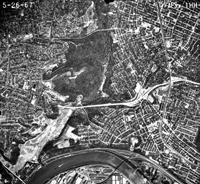
Nine Mile Run, 1967
As the next phase of Nine Mile Run's interaction with Pittsburgh begins, community involvement in the City's design and management of the site has changed significantly. Public meetings on both the design of the housing and the extension of Frick Park are underway. Changes have been made to the size and the scope of the housing development in order to reduce the concerns of surrounding communities. Nevertheless, organized opposition to the site's reuse exists in both Swisshelm Park and Squirrel Hill. Whether a new degree of cooperation and coexistence can be created this time around remains to be seen.
The failure of civic leadership and community-based organizations to cooperate, even to communicate, in the face of the disaster at Nine Mile Run is obvious. The paternalism of the Civic Commission and Citizens Committee may have made such cooperation impossible. Thereafter, the Allegheny Conference and the Pittsburgh renaissance ignored the area in favor of the central business district. Swisshelm Park, as a neighborhood, lacked the resources and the clout to effect the outcome at Nine Mile Run. Whether collaboration among the city's professional and business leaders and its neighborhoods might have changed the outcome is a tantalizing "what if."
The complicity of the City of Pittsburgh in the destruction of Nine Mile Run is a particularly egregious chapter in its history. The Board of Adjustment and the City Solicitor willfully ignored their own ordinances and procedures in order to expedite Duquesne Slag's operations. The Mayor's office ignored repeated requests from civic leaders to buy the valley and protect it. The need of the steel industry for cheap disposal sites took precedence over community health and the interests of future generations. Whatever the failures and weakenesses of the neighborhoods and the various public-private partnerships, they do not excuse the failure of leadership at every level in the City government.
The failure of Progressive-era environmental reformers and of neighborhood groups at Nine Mile Run is significant and presaged many future problems. As Roy Lubove pointed out, progressive reformers were elites with little public support. The coalition favoring environmental improvement did not seek any broader social improvement that might have taken support away from the Magee machine or prevented Duquesne Slag from doing damage to the valley. Bureaucratic management, in the end, was not able -- and often did not try -- to stem the sea of waste and pollution that was enveloping Pittsburgh and the industrial heart of America. Community groups without the backing of civic leadership could do little but complain.
Of the variables involved in the decision to turn a greenway into a slag pile, some were endemic to Pittsburgh. These included a tradition of decentralized decision-making which made it difficult to impose the community's will on the landscape. Other variables were less parochial. The list here might include the unwillingness of government to intervene in the commodification of the landscape; the lack of power and resources available to bureaucratic professionals in the city and in civic institutions, the weakenss of neighborhood groups in large cities, and the business community's inability to police itself. These variables effectively undermined public-private partnerships in their effort to prevent the loss of irreplaceable landscapes such as Nine Mile Run. Moreover, they point to the weakness of such partnerships in the early to mid-20th century: lacking political power and economic resources, they were no match for heavy industry.
Limerick's first draft of history -- unrestrained economic development creating a bountiful society -- was challenged at Nine Mile Run by elites and by neighborhoods seeking to use bureaucratic means to limit the ravages of industrial production. This second draft provided no more benefit to Nine Mile Run than did the first. As the third draft gets underway, a variety of community and civic leaders are taking direct action to protect their interests, including protest meetings and grassroots organizing. The Urban Redevelopment Authority and the Mayor are seeking to engage these concerns in a more direct manner than has been seen at Nine Mile Run heretofore. Whether this third draft will have a happier ending than the first two is uncertain. Yet, for the first time in 60 years, there is some hope that Olmsted's vision for Nine Mile Run might, in some small way, come to pass.
- Unpublished remarks of Dr. George Woodwell to the Rachel Carson Homestead Association's Annual Dinner, April 24, 1997, Pittsburgh, Pennsylvania.
- Patricia Nelson Limerick, "The Forest Reserves and the Argument for a Closing Frontier," in The Origins of the National Forests, ed. Harold K. Steen (Durham, N.C.: The Forest History Society, 1992) 16.
- Catherine Elizabeth Reiser, Pittsburgh's Commercial Development (Harrisburg: Pennsylvania Historical and Museum Commission, 1951), 3, 191-194, 213
- Margaret Byington, Homestead: The Households of a Mill Town (1910: reprint: Pittsburgh: The University of Pitsburgh Press, 1996) 3.
- Joel A. Tarr, "The Pittsburgh Survey as an Environmental Statement," in Pittsburgh Surveyed, eds. Maurine Greenwald and Margo Anderson (Pittsburgh: University of Pittsburgh Press, 1996) 181-183. Maurine Greenwald, "Visualizing Pittsburgh in the 1900s" in Pittsburgh Surveyed, 133.
- Joel A. Tarr, "Infrastructure and City Building," in City at the Point, ed. Samuel P. Hays (Pittsburgh: University of Pittsburgh Press, 1989) 228, 240.
- John F. Bauman and Margaret Spratt, "Civic Leaders and Environmental Reform" in Pittsburgh Surveyed, 154. Joel A. Tarr, "The Pittsburgh Survey as an Environmental Statement," in Pittsburgh Surveyed, 170. Joel A. Tarr, "Infrastructure and City Building," in City at the Point, 241.
- Citizens Committee on City Plan, Parks Report (Pittsburgh: Citizens Committee on City Plan, 1923) 65. "Country Club's Initial Play on Golf Course," Pittsburgh Dispatch, July 28, 1901, Sec. 2, p 12.
- Joel A. Tarr, The Search for the Ultimate Sink (Akron: University of Akron Press, 1996), 89, 92-95, 206. Joel A. Tarr, "The Pittsburgh Survey as an Environmental Statement," in Pittsburgh Surveyed, 180.
- Joel A. Tarr, Search for the Ultimate Sink, 169.
- John F. Bauman and Margaret Spratt, "Civic Leaders and Environmental Reform," in Pittsburgh Surveyed, 162-164.
- Bion J. Arnold, John R. Freeman, and Frederick Law Olmsted, City Planning for Pittsburgh, (Pittsburgh: The Pittsburgh Civic Commission, 1909), 5.
- Frederick Law Olmsted, Jr., Main Thoroughfares and the Down Town District, (Pittsburgh: Pittsburgh Civic Commission Report Number 8 [published by Mount Pleasant Press, Harrisburg] 1911), 119-120
- Bauman and Spratt, "Civic Leaders and Environmental Reform," in Pittsburgh Surveyed, 162-164.
- Tarr, Search for the Ultimate Sink, 85. Tarr, "Infrastructure and City Building," in City at the Point, 243. Roy Lubove, Twentieth Century Pittsburgh (New York: John Wiley & Sons, 1969) 53.
- Tarr, Search for the Ultimate Sink, 86. Lubove, Twentieth Century Pittsburgh, 54. Pittsburgh Department of City Planning, Report of the Department of City Planning for the Year Ending January 31, 1913 (Pittsburgh: Department of City Planning, 1913), 13-18, 25.
- Interview with Frank Curtick, Heinz family historian, February 26, 1997, The Heinz Family Office, Pittsburgh, Pennsylvania.
- Pittsburgh Regional Planning Commission, Prelude to the Future (Pittsburgh: Pittsburgh Regional Planning Commission,1968), 4-6.
- Pittsburgh Regional Planning Commission, Prelude to the Future, 6.
- Pittsburgh Regional Planning Commission, Prelude to the Future, 11.
- Citizens Committee on City Plan, Parks Report, 11-15, 65.
- Citizens Committee on City Plan, Parks Report, 15, 69-71.
- Lubove, Twentieth Century Pittsburgh, 94-95.
- Pittsburgh Department of City Planning, Arguments against the Proposed Zoning Ordinance (Pittsburgh: Department of City Planning, 1923), 3-4, 20. "Zoning Bill to Govern Building Operations Here Sent to Council," The Pittsburgh Press, January 22, 1923, 7.
- Pittsburgh Regional Planning Commission, Prelude to the Future, 246.
- Lubove, Twentieth Century Pittsburgh, 95.
- Pittsburgh Department of City Planning, Map of Pittsburgh Zoning (Pittsburgh: Department of City Planning, 1923), n.p. Interview with Howard Shubel, former Duqusne Slag Products Company employee, March 18, 1997, Pittsburgh, Pennsylvania. Chester Environmental, Nine Mile Run Phase I Environmental Assessment Report, Appendix B (Pittsburgh: Chester Environmental, 1995), 1-5. Map of Nine Mile Run Valley Properties, from the collection of Mr. and Mrs. Thomas J. Horrocks, Pittsburgh, Pennsylvania, used by permission of Mr. Samuel Edelman.
- Cheryl Cvetic Solomon, Slag -- Iron and Steel (Washington: U.S. Bureau of Mines, 1993), 1-5. Testimony of Duqquesne Slag products Company before the City Council of Pittsburgh, February 15, 1957, from the collection of Mr. and Mrs. Thomas J. Horrocks.
- Interview with Howard Shubel, March 18, 1997.
- Testimony of Duquesne Slag Products Company before the City Council of Pittsburgh, April 5, 1953, in Pittsburgh City Council Hearing Book, 1953 (Pittsburgh: Pittsburgh City Council, 1953), 291. Testimony of William A. Robison before the City Council of Pittsburgh, April 3, 1953, in Pittsburgh City Council Hearing Book, 1953, 295-296. Interview with Howard Shubel, March 18, 1997. Chester Environmental Nine Mile Run Phase I Environmental Assessment Report, 5.
- Citizens Committee on City Plan, Parks Report, 69-71.
- Interview with Swisshelm Park Resident Al Protheroe, April 24, 1997, Pittsburgh, Pennsylvania. Chester Environmental, Nine Mile Run Phase I Environmental Assessment Report, 5, see also Appendix A, 8-9. \
- see the Articles of Incorporation, Swisshelm Park Civic Association, 1937, from the collection of Mr. and Mrs. Thomas Horrocks. Correspondence of Richard H. Dick, Swisshelm Park Board of Trade, to C. L McKenzie, President, Duquesne Slag Products Company, November 7, 1939, Horrocks collection.
- Decision of the Board of Zoning Adjustment, January 20, 1947, from the Horrocks collection. Correspondence of Mrs. Thomas Horrocks to Charles F. Miller, Board of Zoning Adjustment, January 21, 1947, Horrocks collection. Correspondence of W. B. Jones, President, Duquesne Slag Products Company to Swisshelm Park Civic Asssociation, October 17, 1946, Horrocks collection.
- Testimony of Duquesne Slag Products Company before the City Council of Pittsburgh, May 3, 1950, in Pittsburgh City Council Hearing Book, 1950 (Pittsburgh: Pittsburgh City Council, 1950), 508-509. Testimony of Paul Good before the City Council of Pittsburgh, May 3, 1950, Pittsburgh City Council Hearing Book, 1950, 510. Minutes of the Emergency Meeting of the Swisshelm Park Civic Association, May 28, 1950, from the Horrocks collection.
- Testimony of Duquesne Slag Products Company before the City Council of Pittsburgh, June 5, 1950, in Pittsburgh City Council Hearing Book, 1950 (Pittsburgh: Pittsburgh City Council, 1950), 520-521. Testimony of Thomas Horrocks, et. al., before the City Council of Pittsburgh, June 5, 1950, in Pittsburgh City Council Hearing Book, 1950 522.
- Correspondence of J. Frank McKenna, Pittsburgh Solicitor, to City Council, February 14, 1955, from the collection of Mr. and Mrs. Thomas J. Horrocks. Unpublished transcript of Pittsburgh City Council Hearings on Nine Mile Run, March 29, 1954, Horrocks collection.
- Correspondence of Frank J. Gaffney, Esq., to the Swisshelm Park Civic Association, December 19, 1955 and March 23, 1956, collection of Mr. and Mrs. Thomas J. Horrocks. Undated notes of Mrs. Thomas J. Horrocks, Horrocks collection.
- Interview with Nancy Horrocks Thomas, former Swisshelm Park resident, April 17 and 22, 1997, Pittsburgh, Pennsylvania. See also Testimony of Duquesne Slag Products Company before the City Council of Pittsburgh, February 15, 1957, from the collection of Mr. and Mrs. Thomas J. Horrocks.
- Tom Barnes, "City Buying Slag Pile," The Pittsburgh Post-Gazette October 13, 1995, Sec. B, p. 1. Correspondence of Anthony G. Giorgione, A. C. Ackenheil & Associates, Inc., to Duquesne Slag Products Company, June 23, 1970, from the collection of Mr. and Mrs. Thomas J. Horrocks.

